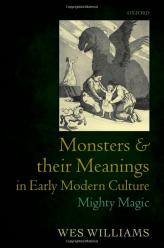Université Paris-Sorbonne(Paris-IV) Agence Nationale de la Recherche
Monsters and their Meanings in Early Modern Culture
Mighty Magic
par Wes Williams
Hardcover : 360 pages
Editeur: Oxford University Press
Langue: Anglais
Date: Mai 2011
ISBN: 978-0-19-957702-6
Format: 234x156mm
Book description
- A new and compelling account of the interconnectedness of history, medicine, politics, myth, and literature in early modern culture
- Charts the process of sustained and distinctive change in the cultural significance of the monstrous from the mid-sixteenth century to the late seventeenth
- Includes original readings of major works of French literature by Montaigne, Rabelais, Ronsard, and Racine
- All French passages are translated
To call something 'monstrueux' in the mid-sixteenth century is, more often than not, to wonder at its enormous size: it is to call to mind something like a whale. By the late seventeenth 'monstrueux' is more likely to denote hidden intentions, unspoken desires. Several shifts are at work in this word history, and in what Othello calls the 'mighty magic' of monsters; these shifts can be described in a number of ways. The clearest, and most compelling, is the translation or migration of the monstrous from natural history to moral philosophy, from descriptions of creatures found in the external world to the drama of human motivation, of sexual and political identity.
This interdisciplinary study of monsters and their meanings advances by way of a series of close readings supported by the exploration of a wide range of texts and images, from many diverse fields, which all concern themselves with illicit coupling, unarranged marriages, generic hybridity, and the politics of monstrosity. Engaging with recent, influential accounts of monstrosity - from literary critical work (Huet, Greenblatt, Thomson Burnett, Hampton), to histories of science and 'bio-politics' (Wilson, Céard, Foucault, Daston and Park, Agamben) - it focusses on the ways in which monsters give particular force, colour, and shape to the imagination; the image at its centre is the triangulated picture of Andromeda, Perseus and the monster, approaching.
The centre of the book's gravity is French culture, but it also explores Shakespeare, and Italian, German, and Latin culture, as well as the ways in which the monstrous tales and images of Antiquity were revived across the period, and survive into our own times.
Readership: Students and scholars of early modern literature and culture

